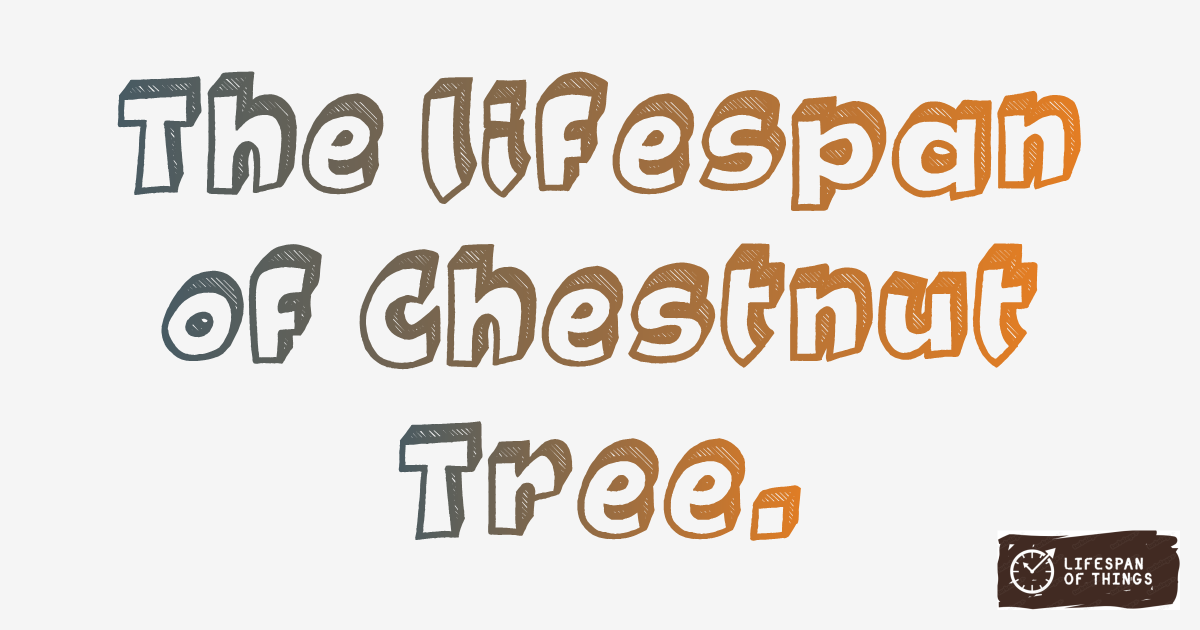
100 - 300 Years
Lifespan of Chestnut Tree is 100 - 300 Years. Chestnut trees thrive in temperate climates and can live up to 300 years. Factors like soil quality, water availability, and sunlight exposure affect their lifespan. Regular care, such as pruning and proper watering, can help extend their longevity.
Useful Information
Chestnut trees grow best in well-drained soil with ample sunlight. They require moderate rainfall and protection from harsh weather conditions. Mature chestnut trees develop deep root systems that help stabilize soil and prevent erosion.
Chestnut trees contribute to the environment by improving air quality through the absorption of carbon dioxide. They also provide habitat for various wildlife species and support biodiversity. Their fallen leaves enrich the soil, promoting the growth of other plants.
Chestnut wood is valued for its strength and durability, commonly used in construction and furniture making. The chestnuts themselves are a food source for wildlife and can be used in cooking. Chestnut trees also have cultural significance and are used in traditional medicines.
Conservation efforts for chestnut trees focus on protecting them from diseases and preserving their natural habitats. Reforestation projects and sustainable forestry practices aim to maintain healthy chestnut populations. Individuals can contribute by supporting conservation organizations and participating in planting initiatives.
Notable examples of chestnut trees include the ancient Castañar de Ibor in Spain, known for its vast chestnut forest. The American Chestnut Tree, once abundant in the eastern US, faced near extinction due to disease but conservation efforts have led to its recovery. These examples showcase the cultural and historical significance of chestnut trees.
Explore famous examples of nut trees, such as ancient chestnut trees in Europe and iconic walnut trees in California, known for their historical significance and cultural importance. Read more
Lifespan Comparisons
| Compared Item | Comparison Description |
|---|---|
| Lifespan of Walnut Tree | Chestnut Trees can live as long as Walnut Trees, with a lifespan of 200-300 years. |
| Lifespan of Pecan Tree | Similar to Pecan Trees, Chestnut Trees have a lifespan of 200-300 years, lasting for centuries. |
| Lifespan of Almond Tree | Almond Trees have a shorter lifespan compared to Chestnut Trees, lasting 50-100 years. |
| Lifespan of Hazelnut Tree | Hazelnut Trees share a similar lifespan range with Chestnut Trees, lasting 50-100 years. |
| Lifespan of Garnet | Both Garnet and Chestnut Trees can thrive for 100-300 years, showcasing enduring longevity. |
| Lifespan of Peridot | Peridot Trees last a shorter period compared to Chestnut Trees, with a lifespan of 50-100 years. |
| Lifespan of Aquamarine | Aquamarine Trees and Chestnut Trees have a similar lifespan range of 100-300 years, enduring for centuries. |
| Lifespan of Famous Rivers | While Famous Rivers last for thousands of years, Chestnut Trees demonstrate remarkable longevity over centuries. |
| Lifespan of Spinach | Spinach has a short lifespan of only 5-7 days, contrasting starkly with the enduring presence of Chestnut Trees. |
| Lifespan of Carrots | Carrots last for 14-21 days, showing a significantly shorter lifespan compared to the centuries-old Chestnut Trees. |
| Lifespan of Broccoli | Broccoli has a brief lifespan of 7-10 days, in stark contrast to the long-lived Chestnut Trees lasting for centuries. |
| Lifespan of Potatoes | Potatoes have a moderate lifespan of 30-60 days, significantly shorter than the centuries-old Chestnut Trees. |
| Lifespan of Bell Peppers | Bell Peppers outlast Chestnut Trees by a few years, with a lifespan of 10-15 years. |
| Lifespan of Apples | Apples have a short lifespan of 7-10 days, contrasting with the enduring presence of centuries-old Chestnut Trees. |
| Lifespan of Oranges | Oranges last for 10-15 days, showcasing a significantly shorter lifespan compared to centuries-old Chestnut Trees. |
Frequently Asked Questions
Lifespan of Chestnut Tree is 100 - 300 Years.
To ensure healthy growth, plant your Chestnut Tree in well-drained soil with ample sunlight and protect it from harsh weather conditions.
Chestnut trees improve air quality by absorbing carbon dioxide, provide habitat for wildlife, support biodiversity, and enrich the soil with fallen leaves.
Chestnut wood is valued for its strength and durability, commonly used in construction and furniture making.
Support conservation organizations, participate in planting initiatives, and promote sustainable forestry practices to help protect Chestnut Trees.








